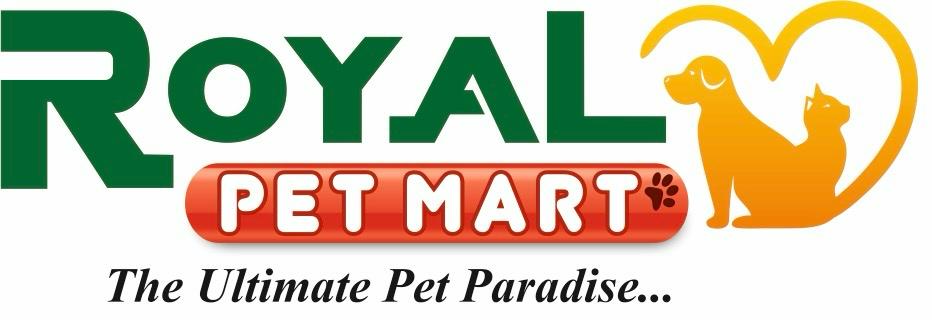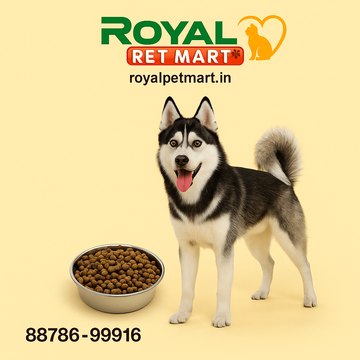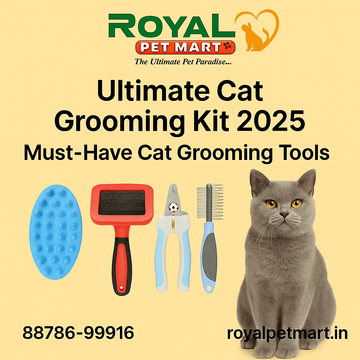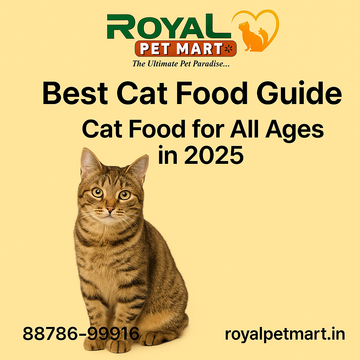Why You Should Use a Slow Feeder Bowl for Your Pets
by Royal Pet mart on May 08, 2025
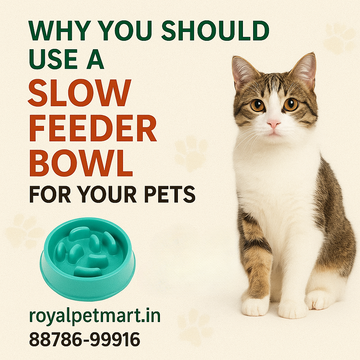
Introduction
I have always loved watching my dog, Milo, eat. He is a silly golden retriever and gets so worked up when it is time to eat that he nearly inhales his food in a matter of seconds. But a few months ago, he started throwing up right after he would eat, and it made me nervous. So, I took him to the vet, and she told me he was eating way too fast and that too much fast eating can be extremely harmful, like bloating or choking. It was during that visit that I first learned about a slow feeder pet bowl; and it has been nothing but positive for us since! Slow feeder bowls help pets eat more slowly. I had no idea how much help they can provide in areas like digestion and behavior. In this blog, I’m sharing what I’ve learned about the slow feeder bowl benefits, why eating too fast is a problem, and how to decide if your pet could use one too. Let’s dive into why this simple tool might be just what your furry friend needs.
What Is a Slow Feeder Bowl?
When I first started my research into slow feeders I wasn't sure what they were, I imagined a standard dog bowl, but they're a bit more than that. A slow feeder pet bowl is a specially created bowl that slows down eating through some design feature that makes it a little harder for your pet to get to their food. Slow feeder bowls can have all sorts of slow feeder bowl design features like maze patterns, raised ridges, or even little obstacles that force your pet to work around just to eat! I found one with a spiral pattern for Milo, and it’s so cute to watch him nudge his nose through the grooves to get his kibble.
There are different types of slow feeders depending on your pet’s needs—I saw ones with simple ridges for beginners and more complex maze patterns for pets who need a bigger challenge. They’re made from a few materials commonly used, like plastic, silicone, or stainless steel. I picked a silicone one because it’s soft and non-slip, but I’ve heard stainless steel is great for durability, and plastic ones are usually the most affordable. I found a great selection on Royal Pet Mart, and it was so easy to find one that looked perfect for Milo. Knowing what a slow feeder is and how it works made me so excited to try it out—I could already imagine how much better mealtime would be for him.
Why Eating Too Fast Is a Problem
I didn’t realize how big of a deal eating too fast was until the vet explained the health risks to me, and it really opened my eyes. One of the scariest risks is choking—Milo would gulp down his food so fast that I was always worried he’d get a piece stuck in his throat. The vet also told me about vomiting, which was exactly what I’d been seeing with Milo—he’d eat so quickly that his stomach couldn’t handle it, and he’d throw up right after. That was tough to watch, and I felt so bad for him.
Then comes the issue of bloating, especially for dogs like Milo who are large and deep-chested because golden retrievers are one of the few breeds who are prone to getting what’s called gastric torsion, which is a twisting of their stomach and a life-threatening ailment where too much air is swallowed by the dog. So that made me aware that I needed to take action to avoid bloating in dogs! Also, eating too fast can be a direct factor in obesity, as pets do not have the capacity for knowing they’re full until they see the empty bowl, at which time they’ll just keep eating until it’s gone which will ultimately lead to weight gain. And there are behavioral issues regarding eating too fast and aggression around food. Milo would get very guarded of his bowl when he ate that fast - it was stressful for both of us when it was mealtime. I realized that it was very important to slow Milo down after I learned about these problems and was very happy that I discovered slow feeder bowls.
Benefits of Using a Slow Feeder Bowl
Once I started using a slow feeder with Milo, I saw the slow feeder bowl benefits almost right away, and I couldn’t believe the difference it made. One of the biggest changes was improved digestion for pets—because Milo was eating more slowly, he wasn’t throwing up anymore, and I could tell his stomach was handling the food so much better. He’d take smaller bites and chew more, which is exactly what the vet said he needed.
It also helped eliminate my worry of choking and bloating. The slow feeder made him slow down, so he was not gulping huge mouthfuls or swallowing air. That alone meant he was choking less and had a significantly reduced risk of any bloating, which makes me feel better. Another huge benefit is controlling his weight and limiting portion sizes—in the past, when Milo ate he was so fast at cleaning his bowl, he begged for more food right afterwards. Now that he is eating slower, he actually feels full with his regular portion. It has really helped keep him in check regards to his weight, especially since he is a large dog and a little glutton.
I was also surprised by how much mental stimulation for pets the slow feeder gave him. The spiral design makes mealtime like a little puzzle—Milo has to figure out how to get the kibble out, and I can see him focusing as he works through it. It’s like a game for him, and it keeps him engaged instead of just scarfing down his food in seconds. Plus, it’s helped with calm mealtime habits for pets—he’s not as frantic or protective over his bowl anymore, and mealtime feels so much more peaceful for both of us. These benefits have made such a difference, and I’m so glad I gave a slow feeder a try.
Which Pets Benefit Most from Slow Feeders?
I started wondering if slow feeders are good for all pets, or if some need them more than others, and I found out there are definitely certain pets that benefit the most. Slow feeder for large dogs like Milo are a must—big breeds or deep-chested dogs, like golden retrievers, labs, or Great Danes, are more prone to bloating, so slowing down their eating is really important for their health. I’ve noticed Milo’s been so much happier since we started using one.
Cats prone to vomiting after eating can also benefit—I have a friend with a cat named Whiskers who used to scarf down her food and then throw up right after. She got a best slow feeder bowl for cats with a simpler design, and it’s made a huge difference—Whiskers doesn’t vomit anymore, and she seems so much more comfortable after eating. Pets on weight management programs are another group that can really use a slow feeder—like I mentioned with Milo, it helps them feel full with less food, which is perfect if your vet has you watching their portions.
I also learned that a slow feeder for multi pet households can be a lifesaver. In homes with more than one pet, mealtime can get chaotic—some pets might eat too fast to “beat” the others to the food, which can lead to fights or stress. A slow feeder can help make things more fair and calm—I wish I’d known about this when I had two dogs growing up! No matter what kind of pet you have, a slow feeder can be a great tool if they’re eating too fast or need a little extra help at mealtime.
How to Choose the Right Slow Feeder Bowl
Picking the right slow feeder for Milo took a little research, but I found some tips that made it easier, and I want to share them for choosing a slow feeder bowl. First, think about size and breed considerations—a big dog like Milo needs a larger bowl with deeper grooves, while a small dog or cat might do better with a shallower design. I made sure to get one that was wide enough for Milo’s snout so he wouldn’t feel cramped while eating.
The bowl material is important too—you want something safe and non-toxic, since your pet will be using it every day. I went with a silicone one because it’s soft and safe, but I also saw some great stainless steel and plastic options on Royal Pet Mart. You’ll also want a bowl that’s easy to clean / dishwasher safe—I picked one I can just pop in the dishwasher because I don’t have time to scrub it by hand every day. Another thing to think about is matching the difficulty level with your pet’s needs—Milo’s a smart dog, so the spiral pattern was perfect for him, but if your pet gets frustrated easily, you might start with a simpler design with just a few ridges. I found so many great options on Royal Pet Mart, and they had reviews that helped me pick the perfect one for Milo.
Tips for Introducing a Slow Feeder Bowl
When I initially provided my dog Milo with his slow feeder, I didn't know how Milo would take to it, so I made sure to be slow in introducing slow feeders to pets. My biggest tip is to introduce the slow feeder gradually—I only put small amounts of food in the bowl the first day so he could get used to it without being overwhelmed. I also made sure to use wet or dry food as that design of slow feeder is based on what type of food he eats—Milo eats dry kibble, which was quite ideal for his slow feeder, but if your pet eats wet food, you should probably use a design with larger grooves so it doesn’t get too messy.
It is important to also pay attention to the pet's reaction and to make changes if needed. The first few times Milo seemed somewhat confused, but I sat with him and provided him with praise and encouragement, like “Good boy, Milo, you are doing great!” After a while, he started to figure it out. After a few days, he was eating from it like a champ, and I could tell he was enjoying the difficulty. If your pet seems really frustrated, you might need to try a simpler design or go back to their regular bowl for a bit before trying again. Taking it slow made the transition so much easier, and now Milo loves his slow feeder.
Common Myths and Misconceptions
I’ve heard a few slow feeder myths for pets that almost made me second-guess using one, so I wanted to clear those up. One big myth is that “slow feeder bowls are frustrating for pets.” I was worried about this too—Milo seemed a little annoyed the first day, but I realized it was because I’d picked a design that was too hard for him at first. The frustration wasn’t the bowl’s fault, it was just a sign of improper fit—once I switched to a simpler spiral pattern, he was totally fine. It’s all about finding the right difficulty level for your pet, not the bowl itself.
Another myth I came across is that “only greedy eaters need them.” I thought this at first too, but even pets who don’t seem like fast eaters can benefit. My friend’s cat Whiskers didn’t eat super fast, but she’d still vomit after meals—using a slow feeder helped her slow down just enough to keep her food down. Slow feeders aren’t just for “greedy” pets—they’re for any pet who could use better digestion, mental stimulation, or calmer mealtime habits. Clearing up these misconceptions made me feel so much better about using a slow feeder for Milo.
Final Thoughts
Using a slow feeder bowl has been one of the best decisions I’ve made for Milo, and I can’t recommend it enough for other pet owners. The slow feeder bowl benefits are incredible—it’s helped with improved digestion for pets, prevent bloating in dogs, and even given Milo some mental stimulation for pets that keeps him happy and engaged. It’s also made mealtime so much calmer, with calm mealtime habits that make both of us less stressed. Whether you’ve got a slow feeder for large dogs like Milo, a slow feeder bowl for cats, or even a slow feeder for multi pet households, it’s a simple tool with big health and behavior payoffs. I found the perfect one for Milo on Royal Pet Mart, and they had so many options to choose from—I’m sure you’ll find one your pet will love too. If you’re worried about your pet’s eating habits or just want to give them a healthier, more engaging mealtime, buy a slow feeder bowl at Royal Pet Mart and see the difference for yourself. It’s such a small change that can make a big impact on your pet’s pet health with a slow feeder and long-term well-being—I’m so glad I gave it a try!
